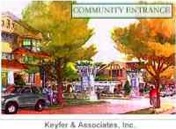






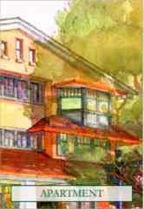


![ATLANTA:4502548.2
Contents
EXECUTIVE SUMMARY....................................................................................4
INTRODUCTION..................................................................................................8
Geographic Boundaries (A)..................................................................................8
Northwest Atlanta: Existing Conditions...............................................................9
Atlanta Housing Authority: A Successful Community Builder..........................11
Atlanta’s Emphasis: Revitalized Communities & Sustainable Growth..............13
Overview of Tax Allocation Districts..................................................................14
PROPOSAL.........................................................................................................15
Grounds for Exercise of Redevelopment Powers (B)..........................................15
Northwest Atlanta Area Qualifies As a Redevelopment Area.............................16
Redevelopment Plan Vision & Goal....................................................................17
Hollywood Road Vision......................................................................................18
Current Market Conditions..................................................................................19
Demographics......................................................................................................20
Northwest Atlanta’s Potential: Future Growth & Development.........................23
Proposed Land Uses after Redevelopment (C)....................................................23
Proposed Redevelopment Projects (D)................................................................23
West Highlands at Perry Boulevard.....................................................................23
Other Redevelopment Projects.............................................................................25
Carver Hills Neighborhood..................................................................................25
Almond Park Neighborhood................................................................................25
Hollywood Road Corridor Improvements...........................................................25
Bolton/Marietta Livable Community Initiative...................................................26
Brockbuilt Development Project..........................................................................26
Brantley Street Development...............................................................................26
General Shale Brickworks Development Project................................................26
Contractual Relationships (E)..............................................................................26
Relocation Plans (F).............................................................................................27
Zoning & Land Use Compatibility (G)................................................................27
Method of Financing / Proposed Public Investments for TAD (H).....................28
Assessed Valuation for TAD (I)..........................................................................28
Page - 3 -
Historic Property within Boundaries of Redevelopment Area (J).......................29
Creation & Termination Dates for TAD (K).......................................................29
Tax Allocation Increment Base (M)....................................................................29
Property Taxes for Computing Tax Allocation Increments (N)..........................30
Tax Allocation Bond Issues (O, P, Q).................................................................30
Amount of Bond Issue.........................................................................................30
Term of the Bond Issue or Issues.........................................................................30
Rate of Bond Issue...............................................................................................30
Positive Tax Allocation Increments.....................................................................30
Property to be Pledged for Payment of the Bonds...............................................31
APPENDICES.....................................................................................................32
Appendix A. Maps & Drawings
1A. Redevelopment Plan Boundary Map (L)
1B. TAD Boundary Map
2A. Redevelopment Area Boundary Description (A)
2B. TAD Boundary Description
3. Northwest Atlanta Existing Land Use (Map 3, Northwest Atlanta Framework Plan)
4. Northwest Atlanta 15-year Land Use (Map 4, Northwest Atlanta Framework Plan)
5. Northwest Atlanta Current Zoning (Map 5, Northwest Atlanta Framework Plan)
6. Northwest Atlanta Flood Plain (Map 8, Northwest Atlanta Framework Plan)
7. Northwest Atlanta Transportation Improvements (Map 30, Northwest Atlanta Framework Plan)
8. Proposed Changes to CDP 15-year Land Use Plan (Map 32, Northwest Atlanta Framework Plan)
9. West Highlands at Perry Project Renderings
10. List of Tax Parcel ID Numbers (Redevelopment Area)
11. List of Tax Parcel ID Numbers (TAD)
12. Redevelopment Projects Map
Appendix B....................................................City of Atlanta Mayor & Council
Appendix C.........................................Fulton County Board of Commissioners
Appendix D..............................................................Atlanta Board of Education
Appendix E....................Atlanta Housing Authority Board of Commissioners
Appendix F............................................................................................Resources
* Headings followed by a letter in parenthesis [e.g. (A)] denote information required per Georgia Code Chapter 36, Title 44.](NWTad_files/shapeimage_2.png)
November 2002
This is not the complete plan


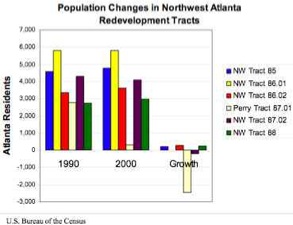
Employment. Unemployment in these tracts is rising faster than it is in Atlanta and the State. The unemployment rates for these tracts for more than a decade have been 50 percent higher than those of Fulton County, metro Atlanta and the State. Recent growth in the labor force and new jobs shows no signs of closing this gap. The working age population in this area would benefit from the new jobs that historically follow redevelopment growth in a tax allocation district.
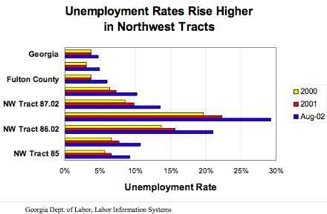

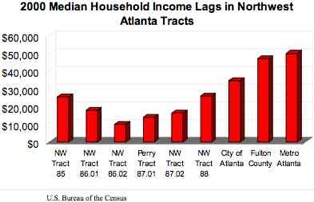



![Proposal
Grounds for Exercise of Redevelopment Powers (B)
Tax Allocation Districts (TAD) are authorized in Georgia under the Redevelopment Powers Act, Chapter 44, Title 36. A tax allocation district is a tool used to publicly finance certain redevelopment activities in underdeveloped or blighted areas. A TAD derives its funding from the increase in the redevelopment area’s ad valorem tax revenues as a result of new development. These revenues are placed in a special redevelopment fund for the area and are used to directly pay for the redevelopment costs or to issue bonds to pay for redevelopment costs.
Page - 16 -
In 2001, House Bill 409 was enacted to amend the Redevelopment Powers Law. The new bill was created to change the legislative purpose of this law “to expand the meaning of redevelopment” and “to change the characteristics of areas eligible for designation as
redevelopment areas,” among the reasons cited in the first paragraph of the bill. “Redevelopment area” now means “any area located within an urbanized or developed area which is substantially underutilized by containing open lots or parcels of land...any geographic area that is adversely affected by airport or transportation related noise or other environmental degradation, contamination, or other environmental factors which the political subdivision has determined to be impairing or retarding the redevelopment of the area....” A redevelopment area is also defined as “[a]ny urbanized or developed area which by reason of a
predominant number of...inadequate parking, roadways, bridges, or public transportation facilities incapable of handling the volume of traffic flow into or through the area, either at present or following proposed redevelopment” and “any open area located within an urbanized or developed area within the corporate limits of a municipality which because of any factor or combination of factors enumerated...substantially impairs or arrests the sound growth of the community.”
Northwest Atlanta Area Qualifies As a Redevelopment Area
With the formation of its Westside Tax Allocation District, the City of Atlanta was the first in Georgia to exercise its redevelopment and other powers authorized by the State pursuant to the Redevelopment Powers Law. Within this TAD and the Atlantic Steel TAD, the City continues to exercise this authority, as now or hereafter amended, provided for by Chapter 44 of Title 36 of the O.C.G.A. As recognized in the City’s planning documents, the land parcels in Northwest Atlanta proposed for inclusion in the Northwest Atlanta Redevelopment Plan qualify as a Redevelopment Area under this statute.
Specific components of the proposed Northwest Atlanta redevelopment area that apply under the Act illustrate its condition as a poor candidate for attracting private funding without a public partner:
• The presence of a predominant number of substandard, deteriorated, or deteriorating structures and of vacant, underutilized lots that substantially impair and arrest the sound growth of the community, that
• retard the provision of housing accommodations or employment opportunities,
• and constitute an economic or social liability that is a menace to public health, safety, morals, and welfare in its present condition and use, and
• A substantial number of buildings that are 40 years old or older and are severely underutilized.
• Other related environmental degradation due to the area’s difficult topography and location within a flood plain and adjacent to a former landfill, and
Page - 17 -
• The area’s substantially underdeveloped characteristics.](NWTad_files/shapeimage_8.png)





